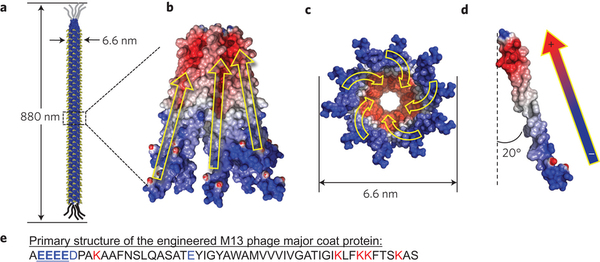Update 2012-08-14
Piezoelectric virus M13 bacteriophage could power your mobile phone | Mail Online
- Virus can turn movement into electricity
- Could one day power your mobile phone or a pacemaker as you walk
A team at the University of California, Berkeley has discovered how to generate electricity from a virus known as M13 bacteriophage.
The virus possesses a property known as piezoelectricity, which means it can translate mechanical energy into electrical energy.
The researchers believe the discovery could one day pave the way for mobile phones that can be charged while you walk and replace the toxic piezoelectric elements already used in mobile phones.
Generating electricity from viruses as you walk | KurzweilAI
Scientists from the U.S. Department of Energy’s Lawrence Berkeley National Laboratory (Berkeley Lab) have developed a way to generate power using harmless viruses that convert mechanical energy into electricity.
The generator produces enough current to operate a small liquid-crystal display. It works by tapping a finger on a postage stamp-sized electrode coated with specially engineered viruses. The viruses convert the force of the tap into an electric charge.
Berkeley Lab Scientists Generate Electricity From Viruses « Berkeley Lab News Center
The scientists tested their approach by creating a generator that produces enough current to operate a small liquid-crystal display. It works by tapping a finger on a postage stamp-sized electrode coated with specially engineered viruses. The viruses convert the force of the tap into an electric charge.
Their generator is the first to produce electricity by harnessing the piezoelectric properties of a biological material. Piezoelectricity is the accumulation of a charge in a solid in response to mechanical stress.
The first part of the video shows how Berkeley Lab scientists harness the piezoelectric properties of a virus to convert the force of a finger tap into electricity. The second part shows the “viral-electric” generators in action, first by pressing only one of the generators, then by pressing two at the same time, which produces more current.[...]
When pressure is applied to the generator, it produces up to six nanoamperes of current and 400 millivolts of potential. That’s enough current to flash the number “1” on the display, and about a quarter the voltage of a triple A battery.
“We’re now working on ways to improve on this proof-of-principle demonstration,” says Lee. “Because the tools of biotechnology enable large-scale production of genetically modified viruses, piezoelectric materials based on viruses could offer a simple route to novel microelectronics in the future.”
Virus-based piezoelectric energy generation : Nature Nanotechnology : Nature Publishing Group
a, The M13 phage [...] b, Side view of the electrostatic potential of M13 phage [...] c, Vertical cross-sectional view of the electrostatic potential of M13 phage.[...] d, Side-view representation of the electrostatic potential of a single M13-phage [...]
Source: Virus-based piezoelectric energy generation : Nature Nanotechnology : Nature Publishing Group
Related
- Lawrence Berkeley National Lab researchers generate electricity with viruses | abc7news.com
- Scientists create first electricity generator powered by viruses | ZDNet
- Lawrence Berkeley National Laboratory
- The Seung-Wuk Lee Lab | Home
- Portable, Virus-Powered Recharging Source On The Horizon? - Technology News - redOrbit
- Viruses Harnessed to Create Energy | LiveScience
- Virus could lead to motion-powered gadgets - Smartphones & PDA Phones
- Electronics Go Viral - ScienceNOW



